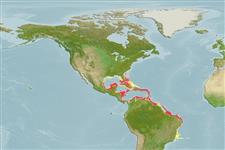分类 / Names
俗名 | 同种异名 | Catalog of Fishes(属, 种) | ITIS | CoL | WoRMS | Cloffa
Environment: milieu / climate zone / depth range / distribution range
生态学
海洋 礁区鱼类; 深度上下限 1 - 200 m (Ref. 9710). 熱帶
Western Central Atlantic: northern coast of South America. The junior synonym, Batrachus uranoscopus, found listed in the IUCN Red List of Threatened Species [as Vulnerable B1ab (I,iii) + 2ab (I,iii), based on a 2001assessment] is thus not justified (Ref. 81293).
中西大西洋: 南美洲的北海岸。
大小 / 重量 / 年龄
Maturity: Lm ? range ? - ? cm
Max length : 20.0 cm TL 雄鱼/尚未辨别雌雄; (Ref. 5217); common length : 12.0 cm TL 雄鱼/尚未辨别雌雄; (Ref. 3273)
背的软条 (总数) : 17 - 20; 臀鳍软条: 16 - 19.
Inhabits the sandy bottoms of reef flats, lagoons, and seaward reefs (Ref. 9710). Partially buried in mud or sand. Wounds from the venomous spines have caused severe pain and illness that persisted as long as one week (Ref. 13442).
栖息于礁石平台,泻湖与临海礁石的砂质底部。 (参考文献 9710) 身体的一部分埋藏在泥或沙子中。 创伤从有毒的棘曾引起剧烈的痛苦与疾病持续长达一个星期.(参考文献 13442)
Life cycle and mating behavior
成熟度 | 繁殖 | 产卵场 | 卵 | 孕卵数 | 仔鱼
中西大西洋: 南美洲的北海岸。
Collette, B.B., 1966. A review of the venomous toadfishes, subfamily Thalassophryninae. Copeia 1966(4):846-864. (Ref. 30721)
世界自然保护联盟红皮书 (Ref. 130435: Version 2024-1)
人类利用
渔业: 自给性渔业
工具
特别资料
下载 XML
网络资源
Estimates based on models
Preferred temperature (Ref.
123201): 23 - 27.6, mean 26.1 °C (based on 121 cells).
Phylogenetic diversity index (Ref.
82804): PD
50 = 0.5156 [Uniqueness, from 0.5 = low to 2.0 = high].
Bayesian length-weight: a=0.01148 (0.00445 - 0.02962), b=3.07 (2.85 - 3.29), in cm total length, based on LWR estimates for this (Sub)family-body shape (Ref.
93245).
营养阶层 (Ref.
69278): 3.6 ±0.5 se; based on size and trophs of closest relatives
回复力 (Ref.
120179): 中等的, 族群倍增时间最少 1.4 - 4.4年 (Preliminary K or Fecundity.).
Fishing Vulnerability (Ref.
59153): Low vulnerability (10 of 100).
Nutrients (Ref.
124155): Calcium = 54.5 [32.7, 122.1] mg/100g; Iron = 0.604 [0.370, 1.163] mg/100g; Protein = 18.4 [17.2, 19.7] %; Omega3 = 0.225 [0.127, 0.400] g/100g; Selenium = 34.3 [19.5, 67.9] μg/100g; VitaminA = 139 [48, 398] μg/100g; Zinc = 1.22 [0.86, 1.68] mg/100g (wet weight);
